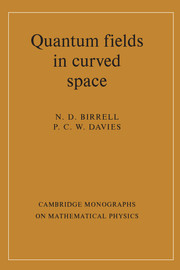Book contents
- Frontmatter
- Contents
- Preface
- Preface to the paperback edition
- Conventions and abbreviations
- 1 Introduction
- 2 Quantum field theory in Minkowski space
- 3 Quantum field theory in curved spacetime
- 4 Flat spacetime examples
- 5 Curved spacetime examples
- 6 Stress-tensor renormalization
- 7 Applications of renormalization techniques
- 8 Quantum black holes
- 9 Interacting fields
- References
- Index
2 - Quantum field theory in Minkowski space
Published online by Cambridge University Press: 05 August 2012
- Frontmatter
- Contents
- Preface
- Preface to the paperback edition
- Conventions and abbreviations
- 1 Introduction
- 2 Quantum field theory in Minkowski space
- 3 Quantum field theory in curved spacetime
- 4 Flat spacetime examples
- 5 Curved spacetime examples
- 6 Stress-tensor renormalization
- 7 Applications of renormalization techniques
- 8 Quantum black holes
- 9 Interacting fields
- References
- Index
Summary
In this chapter we shall summarize the essential features of ordinary Minkowski space quantum field theory, with which we assume the reader has a working knowledge. A great deal of the formalism can be extended to curved spacetime and non-trivial topologies with little or no modification. In the later chapters we shall follow the treatment given here.
Most of the detailed analysis will refer to a scalar field, but the main results will be listed for higher spins also. This restriction will enable the important features of curved space quantum field theory to emerge with the minimum of mathematical complexity.
Much of the chapter will be familiar from textbooks such as Bjorken & Drell (1965), but the reader should take special note of the results on the expectation value of the stress–energy–momentum tensor and vacuum divergence (§2.4), as these will play a central role in what follows. Special importance also attaches to Green functions, treated in detail in §2.7. The reader may be unfamiliar with thermal Green functions and metric Euclideanization. As these will be essential for an understanding of the quantum black hole system, an outline of this topic is given here.
Finally, although we shall not develop a lot of our formalism using the Feynman path-integral technique, we do make use of the basic structure of the path integral in the work on renormalization in chapter 6, and again on interacting fields in curved space in chapter 9.
- Type
- Chapter
- Information
- Quantum Fields in Curved Space , pp. 10 - 35Publisher: Cambridge University PressPrint publication year: 1982



